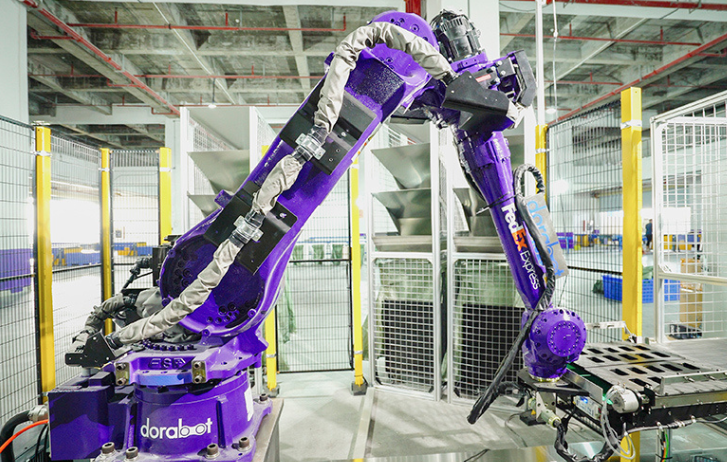
Key Logistics Technology Trends That Can Boost Business Resilience
By Kawal Preet | First published: November 9, 2023 Updated: September 8, 2025
In an uncertain business landscape, smart logistics technology can build resilience into your supply chains. Here’s a look at the top logistics technology trends to leverage.
- Supply chain disruptions are an everyday reality for many businesses today, but new technologies are making it possible to stay agile.
- Advanced analytics and AI can help us unlock useful insights from vast datasets to optimize logistics processes.
- Some smart logistics trends to watch include near-real-time location intelligence, next-level supply chain visibility, and the rise of “elastic” logistics.
It’s often said that the logistics industry never stops moving, with flights and trucks transporting goods round the clock. But it never stops evolving either, with new technologies constantly redefining what agility looks like across the supply chain.
Supply chain disruptions are an everyday reality that many businesses face, ranging from adverse weather to geopolitical tensions. Insights derived from smart logistics technology are helping turn these unpredictable events into more manageable challenges. For example, generative artificial intelligence (genAI) is reshaping the way companies analyze past data to predict future risks.
It’s heartening to see more businesses leaning into the possibilities created by new technology. One in three business leaders in Asia Pacific (APAC) say they feel more optimistic about global trade, thanks to technology’s ability to make supply chains more efficient and resilient.
More than ever, staying ahead will mean staying on top of logistics technology trends and tapping the latest tools to keep your business moving.
From physical to digital: How supply chains have evolved
Historically, supply chain efficiency was all about the physical – the planes, trains, trucks, and sea freighters that drive global commerce. These vehicles worked in tandem with “hard” infrastructure such as cities, ground hubs, and ports to keep supply chains flowing.
But new technology has fundamentally transformed the way we ship, transport, and deliver goods around the world. As e-commerce has grown, every physical shipment now includes a digital layer of data that tracks its status and helps manage its movement across borders.
This data can be as simple as location tags or as sophisticated as near-real-time monitoring of your shipment’s temperature, humidity, and exposure to light. The availability and quality of data within the global supply chain are increasing exponentially – and advanced analytics tools like machine learning and AI are turning that data into actionable insights. By unlocking valuable information from vast datasets, logistics data analytics enables streamlined operations and proactive problem-solving.
The top logistics technology trends to watch
At FedEx, we have been harnessing the power of data for years to develop deep knowledge about our business. With millions of shipments moving across our global network each day, we’re constantly innovating to boost supply chain visibility and enhance predictability. This allows us to track shipments, optimize deliveries, enhance the customer experience, and empower businesses with smarter logistics solutions.
As we take the next step on our digital innovation journey, we see three data-led trends transforming the supply chain:
1. Location intelligence is optimizing delivery routes in real-time
Location intelligence is shaking up how retail, logistics, and other industries work by combining the digital and physical. Simple data visualization on maps is being replaced with data that’s geospatially layered, integrated, and analyzed.
By layering various types of geospatial data – such as traffic patterns, weather conditions, and GPS information – onto a smart map, companies can gain deeper insights into operational dynamics and identify opportunities to optimize processes. When planning last-mile delivery routes, for instance, location intelligence can help analyze past traffic patterns alongside current traffic conditions. This enables businesses to quickly adapt to disruptions and reduce delays in near real time.
End-to-end integration of this data across both digital and physical networks is critical. So, too, is the integration of customer or internal data with that of logistics networks.
For example, we are currently using next-level route planning technology at FedEx. Created by our DataWorks team, this location intelligence “geocodes” pick-up and delivery locations using advanced statistical algorithms. We then layer multiple data points onto digital maps, creating optimal delivery routes that adjust dynamically for the best performance.
2. Supply chain visibility is entering a new era of precision
Supply chain visibility is being completely reimagined beyond location- or spatial-based information. Today, this visibility traverses many different layers.
The Internet of Things (IoT) now makes it possible to seamlessly connect every link in the supply chain, from packages to warehouses. Logistics data analytics and AI in the supply chain provide continuous monitoring and predictive insights about your shipments. The anytime-anywhere access of the cloud brings all this data together, making it easy to access data when and where you need it.
This will deliver even greater impact in the future. Digital control towers with an end-to-end view of the supply chain will be the norm, giving businesses the visibility to make decisions quickly and confidently. When disruption strikes, you’ll be able to anticipate and adjust to limit delays.
FedEx is building towards this future with FedEx Surround, our monitoring and intervention solution for next-level visibility of sensitive shipments. This suite of tools includes SenseAware ID, which uses advanced sensor technology to transmit precise location data every two seconds, as well as an AI-powered dashboard that delivers predictive insights. This allows us to forecast possible issues and intervene early.
3. “Elastic” logistics is enhancing resilience
As the name suggests, elastic logistics is the ability to “stretch” or shrink supply chain operations based on market demand and conditions.
For example, e-commerce businesses experience huge spikes in demand during peak seasons like the year-end holiday rush. In turn, logistics providers need to scale up their schedules and capacity to handle the surge in orders and get goods delivered on time. During slower seasons, being able to scale down capabilities is just as crucial to reduce waste and operational costs.
We have long seen the benefit of adaptive, flexible logistics. Now, it’s rising to new heights through logistics data innovation and predictive analytics, which are connecting siloed processes and uncovering more strategic insights.
For instance, we are using AI to forecast shipping demand and improve our capacity planning. We’re also integrating more robotic process automation (RPA) in our facilities to give us greater “elasticity” to meet demand.
In Singapore, we currently use an AI-powered intelligent sorting robot in our regional hub to optimize operational processes – sorting up to 1,000 packages per hour and covering up to 100 destinations simultaneously. We’ve also introduced a similar robot in our e-commerce shipment sorting center in Guangzhou, which enables us to rapidly scale up sorting during peak season.
What’s ahead for next-generation supply chains?
Looking ahead, we can expect to see smart logistics technologies reshaping every step of the supply chain.
Data will play a pivotal role in helping businesses stay resilient and efficient in the face of supply chain risks. Innovations in AI and data analytics will increasingly guide decision-making across entire organizations, turning logistics challenges into opportunities to stay agile.
At FedEx, we’re always working to leverage logistics technology trends and deliver a better experience for the businesses we serve. As we like to say, innovation is in our DNA – because when supply chains run smarter, businesses can go further too.
SHARE THIS STORY
- 85% Of APAC Businesses Plan To Expand Into Europe, According To New FedEx Report
- Generative AI: A New Frontier
- How To Ship A Giant Panda
- The Rise Of Intra-Asia Trade: Opportunities In The China-Southeast Asia Corridor
- Where Do Old Planes Go When They Retire?
- What’s So Dangerous About Coconuts? Your Guide To Dangerous Goods Logistics
Sign up now and save on your shipping rates!
Sign up now and earn discounts by shipping instantly with FedEx Ship ManagerTM at fedex.com.
Recommended For You

5 Logistics Trends Driving A Smarter Supply Chain
FedEx is delivering both transportation and digital solutions, as it builds a smarter supply chain for everyone.
Read More
How Technology Is Shaping The Future Of Healthcare Logistics
From real-time data to predictive analytics, our digital technologies streamline the process of moving medical supplies and healthcare products.
Read More
How New Technologies Deliver Smarter Supply Chains
Emergent technologies like AI are making supply chains smarter, more resilient and agile. We dive deeper into their potential for FedEx and Asia SMEs.
Read More


